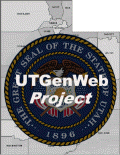Iron County Utah
Part of the UTGenWeb & USGenWeb® Projects
On-Site Records
Biographies & Obituaries
Cemetery Records
History & Maps
Military Records
Vital Records
| search engine by freefind |
County Coordinator
VACANT
This county is Up for Adoption.
For more information and an application contact the State Coordinator Mary Schwanke.
A Brief County History
Evidence of Fremont culture habitation ranging from 750 to 1250 AD exists in present Iron County. Petroglyphs of differing periods were carved into the walls of Parowan Gap NW of Parowan. Paiutes roamed the Parowan Valley in the centuries prior to Euro-American exploration; their descendants are now represented by the Southern Paiute Indian Reservation, which is headquartered in Cedar City.
The Domínguez–Escalante expedition traveled through the Iron County area on October 12, 1776. Fur trapper Jedediah Smith is the first recorded Anglo-American to pass through the area (1826). Settlement of the area began in 1851, when LDS President Brigham Young directed members from the northern colonies to move into the area. A settlement, Coal Creek, sprang up in 1851; it later became Cedar City. To provide a local government structure, the State of Deseret legislature created the county on January 31, 1850, although it was not organized until January 17, 1851, with description stretching from the future Colorado, across Utah, and into the future Nevada. It was named "Little Salt Lake County" at creation, but on December 3, 1850, a legislative act changed its name to Iron County. Its borders were altered in 1850, 1852, 1854, 1856, and 1861. Also in 1861, the federal government created the Colorado Territory, which administratively removed Iron County areas east of 109 degrees longitude.
The county borders were altered in 1862. Also in 1862, the federal government created the Nevada Territory, which administratively removed Iron County areas west of 114 degrees longitude. Further boundary adjustments were passed in 1866, 1880, 1882, 1883, and 1884. The final adjustment was made in 1892; the county borders have remained in their present arrangement since that time.
Land Features
Fremont Pass (6,530 ft), Mount Eleonore (7,820 ft), Hamblin Valley, Needle Range, Wah Wah Mountains, Escalante Desert, Table Butte, Three Peaks, Antelope Peak, Antelope Range, Joel Spring Canyon, Neck of the Desert, Silver Peak, Red Hills, Iron Mountain (7,501 ft), Swett Hills, Swett Peak (6,736 ft), Leach Canyon, Flat Top Mountain (7,225 ft), Stoddard Mountain (8,378 ft), Harmony Mountains, Richie Flat, Kanarra Mountain (9,084 ft), Hurricane Cliffs, Grafe Point, North Hills, Cedar Mountains, Pine Spring Knoll (10,023 ft), Pryor Knoll, Square Mountain, Lone Tree Mountain (9,134 ft), Cedar Canyon, Big Hill, Fiddler's Canyon, Summit Mountain (9,910 ft), Miners Peak (9,243 ft), O'Neil Gulch, Corry Point, Black Mountain (10,375 ft), Hancock Peak, Lava, Housten Mountain (10,060 ft), Blue Spring Mountain, Prince Mountain, Brian Head (11,307 ft), Navajo Ridge, Water Canyon, Parowan Valley, Markagunt Plateau, Little Creek Peak (10,142 ft), Cottonwood Mountain (9,018 ft), Buckskin Valley, Jack Henry Knoll (8,668 ft), Black Mountains, Parowan Canyon, Dry Willow Peak, Long Hollow, Monument Peak (6,780 ft), Blue Knoll (5,626 ft), Mud Springs Hills, Horse Hollow, Lost Spring Hollow, Clark Hollow, The Bald Hill, Hole in the Wall, The Three Peaks, Cedar Valley, Granite Mountain.
Water Features
Antelope Springs, Shoal Creek, Modena City Resevoir, Little Pinto Creek, Dry Wash, Rock Spring, Big Hollow Wash, Dick Palmer Wash, Iron Springs Creek, Mud Spring Wash, Rush Lake, Johnson Creek, Jones Spring, Little Salt Lake, Fremont Wash, Big Wash, Bear Creek, Red Creek, Red Creek Resevoir, Hoosier Lake, Bowery Creek, Center Creek, Yankee Meadows Resevoir, Mammoth Creek, Parowan Creek, Summit Creek, Ashdown Creek, Coal Creek, Eightmile Springs, Quichapa Lake, Shirts Creek, Crystal Creek, Spring Creek, Kanarra Creek, Deep Creek.

